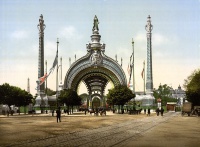Radiolaria
From The Art and Popular Culture Encyclopedia
|
"In late August 1900, when Haeckel travelled from Jena to Java, he stopped briefly in Paris to visit the World Fair where he walked through one of his radiolarians. The French architect René Binet had used Haeckel’s images of the microscopic sea creatures as an inspiration for the Porte Monumentale, the huge metal entrance gate that he had designed for the fair. In the previous year Binet had written to Haeckel that ‘everything about it’ – from the smallest detail to the general design – ‘has been inspired by your studies.’ The fair made Art Nouveau famous across the world, and almost 50 million visitors walked through Haeckel’s magnified radiolarian. Binet himself later published a book called Esquisses Décoratives (Decorative Sketches) which showed how Haeckel’s illustrations could be translated into interior decoration. Tropical jellyfish became lamps, single-celled organisms transmuted into light switches and microscopic views of cell tissues turned into wallpaper patterns. Architects and designers, Binet urged, should ‘turn to the great laboratory of Nature’."--The Invention of Nature (2015) by Andrea Wulf |
|
Related e |
|
Featured: |
The Radiolaria, also called Radiozoa, are protozoa of diameter 0.1–0.2 mm that produce intricate mineral skeletons, typically with a central capsule dividing the cell into the inner and outer portions of endoplasm and ectoplasm. The elaborate mineral skeleton is usually made of silica.
See also


